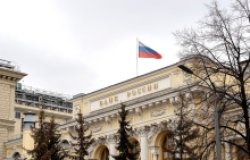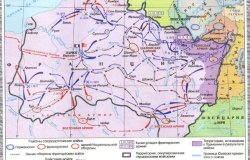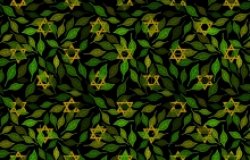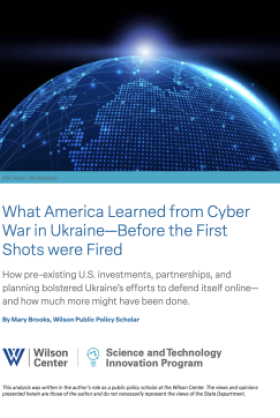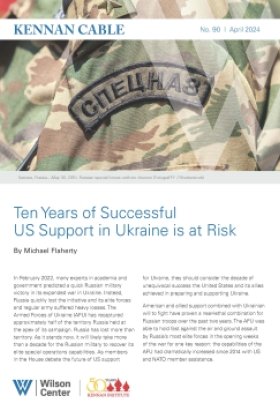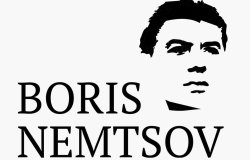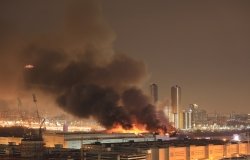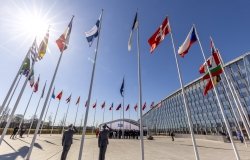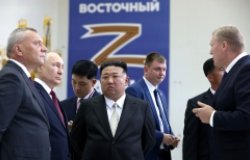The Orange Revolution and the Maidan Parliament
In this speech, former U.S. Ambassador to Ukraine William Green Miller provides a first-hand account of the "Orange Revolution" in Ukraine. Amb. Miller was an election observer for all three rounds of Ukraine's presidential election, including the December 26 election ordered by Ukraine's Supreme Court.
Not long after the 2002 parliamentary elections, I had a long conversation with the wisest and most astute of senior Ukrainian national security officials, Volodymyr Horbulyn, who had been the National Security Advisor to President Kuchma, and his lifelong friend. Horbulyn and I had worked closely together on the many questions surrounding the elimination of all nuclear weapons in the Ukrainian arsenal and the best ways to assure Ukrainian independence and sovereignty. We met frequently over the four and a half years I was Ambassador, generally once a week, and we became good friends. We often discussed the main paths and trends of contemporary Ukrainian politics and governance. We continued our dialogue even after I left Ukraine as Ambassador. Since 1998, I have returned to Ukraine two or three times each year and have had the chance to continue and deepen our dialogue.
On that occasion I referred to, the 2002 parliamentary elections, Horbulyn said to me, "There has been a profound change in the nature of Ukrainian politics. These recently concluded parliamentary elections showed that the party of power has lost majority popular support. Over 75% of the electorate are for new leaders like Viktor Yushchenko, or are opposed to the government and the existing system of governance."
We went on to discuss the nature and composition of the new majority, who the new leaders were, their quality, and in what ways they were different from those who had run Ukraine since independence in 1991. We agreed that Viktor Yushchenko was, by far, the most popular and most respected politician now on the scene. Horbulyn was of the view that the clans and oligarchs now in power would do everything possible to keep Yushchenko from becoming president, but that he had a good chance of winning because of the majority popular support he had been given by the Ukrainian people.
It was clear to me then, and this was affirmed by Horbulyn when we met over the several years since 2002, that there had been a fundamental irreversible transformation in attitude on the part of Ukrainian voters. Certainly, the majority of those who ran for the parliament were supported by new groups other than the long dominant Party of Power, or the successor Communists and Socialists. For the first time too, votes were cast by large numbers of voters whose livelihood did not depend on employment in state organizations. The 2002 elections marked, in a definitive way, the time when a majority of emancipated voters emerged out of the swamp of docile, single party voters so reminiscent of Soviet times.
Strong, coherent political parties did not exist other than the Party of Power, and allied lesser factions which were supported or allowed to function by the Party of Power. However, a formidable opposition to the pervasive corruption and abuses of power found in Ukrainian politics was beginning to take shape.
The Nasha Ukraina coalition led by Viktor Yushchenko (who declared he was not head of any party) had not yet fully formed, but the key personalities had already emerged: of course, Yushchenko, and most significant among the coalition, Tymoshenko, Moroz, Pliushch, Rybachuk, Poroshenko, Kostenko, Udovenko, Tarasyuk, Bessmyrtny, Stretovich, Matvienko, Pynzenyk, Sobelev, Grynyv, Tomenko, Zinchenko, Filenko, Katerynchuk, Ostash, Zayets, Zvarych.
At the same time, the grassroots organizations so necessary for democratic political action were beginning to coalesce, building in part on the youth groups from earlier national movements like Rukh and the environmental organizations arising out of the Chernobyl catastrophe. For over ten years, observer groups for elections were trained, helped in part by OSCE, NDI, IRI, and other U.S. and European NGOs. These observer groups, largely made up of students and young people, became a formidable element in the demand for free, fair, transparent, and honest elections. CVU, for example, turned out 10,000 observers, while over 7,000 international observers joined the ranks of those who watched the votes being cast at the polls to assure their legitimacy. The fight for free, honest elections already evident in the 1998 presidential elections and the 2002 parliamentary elections helped to create, particularly among the youth, a new popular movement of growing strength at the grassroots level. One good example evident in the over 1,000 tents camped on the Kreshchatyk next to the Maidan was Pora (Pora means, "it's time").
In 2002, the Nasha Ukraina coalition first challenged the established leadership in the Rada. Nasha Ukraina almost succeeded in taking over the leadership. However, mistakes made by Yushchenko and others in the coalition allowed the Party of Power groupings of Kuchma loyalists to maintain control of the parliament. Lytvyn survived challenges to his leadership and held on over a very shaky year or so and resisted repeated efforts by Nasha Ukraina to translate their obviously overwhelming popular support into majority Rada rule. The opposition politics of the parliament was a reflection of what was to come in the presidential elections of 2004: There would be a bitter, almost life and death battle between those factions controlled by the clans and oligarchs that were the backbone of the Party of Power and Nasha Ukraina. The oligarchs and clan leaders were people who had been put into power by President Kuchma who had every reason to fear that the growing popular movement that supported Viktor Yushchenko and Nasha Ukraina would sweep them away from position and influence.
During the two years between the parliamentary and the October 21, 2004 presidential elections, the Party of Power did everything possible to destroy the popular support for Yushchenko. They used the media and controlled press to picture Yushchenko as weak, a pawn of the United States and the West, spreading rumors that his American-born wife was a CIA agent. He was characterized as a dilettante, more interested in painting and raising bees than doing the hard work of running a nation. He would be too soft, not tough enough to run Ukraine. This characterization and evaluation of Yushchenko's abilities was held by many in Ukraine, but also in U.S. government circles and in European capitals as well.
The Party of Power used the tax police to harass Yushchenko and his financial supporters. In addition, the Procurator's office was used as a means of harassment and were required to investigate key personalities supporting Yushchenko. These so-called administrative resources extended to the regions where local governors were ordered to use their authority to limit the effect of Nasha Ukraina campaigning. Yushchenko supporters were threatened, beaten, and in some cases, murdered by those using administrative resources.
Yushchenko would have to maintain his popularity by proving his strength of character, integrity, and abilities through two years of intense campaigning. He would have to survive several assassination attempts including a near fatal poisoning. Further, his campaign would face enormous organizational difficulties, a press and TV blockade, shortage of funds, a massive disinformation campaign aimed at destroying his popularity among the Ukrainian people, opposition from many Russians including President Putin, and until the last months before election, a relatively hands-off attitude from the United States government and the West.
Yet, it was more and more evident that the more the party of power led by President Kuchma and the oligarchs and clans that supported Viktor Yanukovych used illegal and brutal means to block Nasha Ukraina's efforts to campaign, the stronger Yushchenko seemed to get. Under adversity he proved his durability. When he started his campaign, he often sounded like an economics professor lecturing to a graduate school seminar, but from daily necessity to communicate, his speaking style grew more passionate, tighter in structure, and more persuasive. Yushchenko learned and was able to speak surrounded by crowds used to pressure and adversity, as one of the people. I was able to witness this remarkable transformation.
When the poisoning took place, there was first shock and horror. He lost a month of campaigning time as he struggled for his life and began to recover in the hospital in Vienna. He was horribly disfigured. Appearing in the parliament, after his return from the hospital inVienna, he made a powerful speech saying, "Look at my face. This is the face of Ukraine. It could happen to any of you here." Immediately, the spin doctors were attributing the poisoning to sushi, gluttony, and alleged that this was a result of Yushchenko's secret high lifestyle. The effects of sowing these rumors and doubts were considerable; many believed the rumors, spread in part by Western public relations firms. It was not until the medical evidence was indisputable some weeks before election, that the overwhelming majority of Ukrainians believed he had been poisoned by TCCD dioxin.
But this murderous attempt that so disfigured the looks of a handsome Yushchenko ironically made him appear to many ordinary Ukrainians as a "man of sorrows," as one trenchant political observer said to me. Certainly, on the Maidan, when Yushchenko spoke, those who looked at him as he spoke to them at the Maidan, or on TV saw a man harmed by a corrupt regime that they hated. They showed that they were in total sympathy with his struggle and believed that he had proved he was fighting for them, even at the risk of his life. The poisoning served to deepen the support of Yushchenko by the people.
There were photos everywhere posted as constant reminders of what Yushchenko looked like before he was poisoned and the daily vision of his present disfigurement. In that kaleidoscope atmosphere of the Maidan with all of its color and beautiful imagery, Yushchenko's face was a harsh grim reality that was seen, understood, and embraced by all.
The miracle of the Orange Revolution is how the parliament of the Maidan came together so suddenly, so coherently, and so effectively. Most importantly, as the Orange Revolution coalesced and became an evolving organism that grew in size and complexity day by day--a growth that I witnessed from its beginning-- and as that crowd of ten thousand or so outraged and angry voters realized they had been cheated by massive fraud, manipulation, and government malfeasance, protest was quickly transformed into a legitimate national expression of popular will. I was fortunate to have rented an apartment just a few footsteps from the Maidan—on Sofieska, the street that descends steeply to the Maidan from St. Sophia Cathedral, the birthplace of Kyivan Rus. Because the Maidan was so close, I was able to witness and participate in the proceedings on the Maidan at all times of day and night. For over three weeks, the tens of thousands who were first on the Maidan were joined by additional tens of thousands who streamed into the center of Kyiv.
By sustained force of collective will and able leadership that had the respect and confidence of the Maidan million, the reaction of the people of disgust and revulsion at the corrupt manipulations and falsifications that had taken place in the election process, the elections of November 21 were overturned by decision of the Supreme Court on December 3 and new elections were set for December 26. The Supreme Court was able to examine the 11,000 charges of fraud and manipulation knowing that an informed and aware populace of millions looked to the Court for impartial justice. After an overwhelming weight of evidence was presented to the Supreme Court, it delivered a unanimous verdict. The majority of the voters of Ukraine wanted this verdict, and knew it was just, because the transgression had been done to them.
Day after day, night after night, the Maidan crowd shared a glorious uplifting spirit and a determination to rid their country of criminality and corruption. As they said in some of their slogans, "bandu het", thieves, crooks—out, and "nas bahato, nas ne podolaty," we are many and we will not be overcome. To those who were on the street, on the Maidan, who shared this experience, it was not surprising that this mass of hundreds of thousands, at times over a million, was transformed into a Maidan Parliament. The creation of the Maidan phenomenon would not have been possible unless certain key conditions had not existed. The Mayor of Kyiv, Olexander Omelchenko, allowed the Maidan to be used by Nasha Ukraina for its gathering. The Mayor and City Council allowed the Khreshchatyk to be occupied by the Pora tent city. Omelchenko and the City Council and the chiefs of militia and SBU could have moved to support Yanukovych but they sided with Yushchenko. This was a crucial political decision. The majority of police and militia of Kyiv were clearly in sympathy with Yushchenko and his Nasha Ukraina coalition supporters. The army and the SBU were held in check. Further, requests for the use of force to clear the Maidan of demonstrations and to limit Yushchenko's activities on the part of Yanukovych and his supporters were not agreed to by President Kuchma. The Speaker of the Rada, Lytvyn, allowed the Rada to be convened to discuss and vote on the fraudulent elections and he brokered a consensus agreement on election and constitutional reform that was crucial to holding the winning coalition together. Olexander Moroz played a vital role in supporting Yushchenko, while pressing for electoral and constitutional reform. Ivan Stepanovich Pliushch was one of several who worked tirelessly behind the scenes working out the compromises needed to allow the December 26 election to take place.
The role of outside forces had a significant impact but overall these were far less important than that played by Ukrainian actors. Putin's interference had a negative effect. Russian pressure served to stiffen Ukrainian resolve and resistance, while the mediation efforts of Kwasnewski, Solana, and others blunted efforts to take forceful police and military measures to maintain control on the part of the Yanukovich forces. Over 7,000 foreign observers monitored the elections along with over 10,000 domestic observers. The cumulative effect of these foreign and domestic observers and of the foreign mediators was a third round election that was relatively free, fair, and transparent. All these measures helped stage the outcome, but the great victory was the result, principally, of the will of the majority of the Ukrainian people who knew they had to fight for their constitutional rights by protest and direct action if they were to elect the man they believed best reflected their view of what a decent, honest leader should be—a man like Viktor Yushchenko. The Maidan Parliament was a spontaneous phenomenon that arose out of the immediate circumstances. It certainly was not planned. (There had been talk, earlier, of taking to the streets to oppose with violence, if necessary, the efforts to close down these Maidan meetings by the authorities if the authorities moved the militia and special forces against the Yushchenko group.) But nothing like the Maidan million was ever imagined. The impetus came from the people themselves.
The Maidan-—both the mass of people and their leaders-—were ready. The Maidan knew what it wanted—-decent, honest governance. They knew what needed to be done: First, "bandu het"-—get the corrupt leaders out, and second, get the decent leaders in, "Yush-en-ko, tak," Yushchenko, yes; third, they believed—-they knew-—they had the legitimate right and the power to carry this desire out. Many in the Maidan knew by heart Article 5 of the Constitution which says: "The people are the bearers of the sovereignty and the only source of power in Ukraine."
Putting together a legitimate, peaceful, popular, revolutionary mass into a well-organized political force was a triumph of intellect, determination, courage, and not least, restraint. Obviously, there is at least a paradox, if not a contradiction, in a movement that is both legitimate and revolutionary. In this case, the revolutionary action of overthrowing a corrupt regime that had abused the institutions of democratic governance was believed to be a legitimate course of action. How the Maidan mass did this is one of the miracles of the Orange Revolution.
The organizational performance of the Maidan was another marvel. For example, just putting together the schedule each day in the context of a very volatile, rapidly changing political situation was impressive. Coordinating what was to be done, who would do it, who would speak at the Maidan, when, who would perform, how the apparatus of the stage lighting, sound systems, camera work, printing of bulletins, communicating assignments, the making of banners, scarves, ribbons, the purchase and distribution of oranges, candles for candlelight meetings, camping equipment and supplies for the tent city of 1,000 plus tents. All of these elements were put together each day—and minute by minute. It was a miraculous organizational achievement.
How the leading clergy from all faiths: Orthodox, Catholic, Muslim, Jewish, were brought together to lead the Maidan in prayer each morning; how the opera singers, army choruses, rock stars, athletic heroes, heavy weight boxing champions, foreign dignitaries, and politicians were all able to converge in a relatively orderly way is a most remarkable organizational feat. What explains this success?
The Nasha Ukraina met at least daily to discuss what needed to be done and to make the immediately required decisions. Who put it all together? Those most responsible and most visible were Rybachuk, Filenko, Poroshenko, Zinchenko, Tomenko, Bessmyrtny, Lutsenko, and of course, Yushchenko, Tymoshenko, and Moroz. The more complete answer goes way beyond those visible, well-known leaders who spoke to the Maidan.
All the various groups and interests that converged on the Maidan were like nodes on the Internet—nodes connected by a common desire to rid the country of corruption and to support leaders who would offer the possibility of honest, decent government. Despite all the diversity among those who made up the Maidan, there was a strongly evident willingness to join in common cause. As one person on the Maidan, I could feel and see the pleasure and pride of the Ukrainians who surrounded me and believed they had risen up from their knees and were standing together as free men and women.
The Orange Revolution, in large measure, was a brilliant, largely spontaneous, and certainly colorful expression of popular will. The choice of orange as a color, as a theme, reflecting the fall season perhaps, was understood to be certainly a totally new color for politics in Ukraine. This difference was seized upon by Yushchenko's supporters and his popular supporters in Kyiv and throughout Ukraine and was used brilliantly.
It was amazing to see how, day by day, new kinds of orange objects would appear on the streets and on the Maidan. Orange scarves, ties, ribbons, raincoats, socks, hats, gloves, banners, orange hair, lipstick, orange sweaters, jackets, shoes, even underwear appeared in shop windows, at street vendor stands and on the Maidan million. All car antennas carried a stream of orange ribbon. The main government buildings were festooned with orange ribbons, banners, and slogans. Almost every tree had orange ribbons dangling from its branches.
Oranges, that is the citrus fruit, became a political staple, if not a radical political weapon. As an example, on one occasion, I was attending a session of the Rada, sitting in the diplomats' section of the gallery during the debate and votes on election reform and constitutional reform. Early in the session, one of the Nasha Ukraina deputies carried a large bag of oranges onto the floor of the Rada and began placing an orange on the desk of every deputy. When he got to the section of the Rada where the Communists have their seats, he encountered a number of outraged Communist deputies who took the oranges on their desks and threw them across the center of the chamber at the Nasha Ukraina deputies on the other side of the chamber. For a few minutes, oranges flew threw the air until the Speaker was able to bring order to the parliament.
It was impressive to watch the Nasha Ukraina whips work the floor of the Rada with their huge orange scarves around their necks. Poroshenko and Pynzenyk were easy to spot as they moved around the chamber. Yulia Tymoshenko wore orange dresses, suits, and I know she advocated the wearing of orange by all patriots. The last time I met with her, just before the December 26 elections, I saw she was wearing an orange sweater with the words "revolution" running down both shoulders and arms.
Since the elections were taking place during the Christmas season, orange Christmas trees appeared and orange decorations for the trees and of course, orange candy, cakes, and even champagne from the great winery, Novy Svet, in Crimea was adorned with orange labels.
Of course, the clothes, ribbons, banners, and other paraphernalia were only the surface of the Orange Revolution—but it was a gentle humorous side of a very serious revolt against the corruption of government and the debasement of Ukraine as a nation in the eyes of the people of Ukraine and the world. The people dressed in orange were saying emphatically and clearly they wanted a different Ukraine, a Ukraine of a decidedly different color, led by different leaders. They wanted to get rid of the thieves who had stolen their patrimony and tarnished their integrity.
The geography of Kyiv contributed in an ideal way for making the Maidan the center of urban democracy in Kyiv. This very large square, a rectangle really, lies in the heart of the city of Kyiv. The main street of Kyiv, the Kreshchatyk, crosses through the middle of the Maidan. It is a major metro stop and bus terminal. While six streets feed into it from Sophia and Mikhailovska to the north. The Maidan is in easy walking distance on broad streets to the Rada (Parliament), the Cabinet of Ministers, the President's offices, City Hall on Bankova, the Supreme Court, the Constitutional Court, and to the Central Election Commission, the main Post Office, and the Trade Union Building, the Tchaikovsky Conservatory, the main Press Center, UNIAN, is nearby as are a plentiful array of restaurants and cafes and fast food places. Underneath the Maidan are restaurants and shops which in the winter provide warmth when the cold weather gets unbearable.
The Maidan is also known as Nezhdelezhny (Independence) Square; the place where sustained demonstrations for independence took place in 1991. The foundation of the South Gate of Kyivan Rus is visible on the north side of the Maidan. The Maidan was not only large enough to be able to hold a huge crowd—-over a million-—it is also convenient and resonant with a thousand years of history.
Nasha Ukraina was able to mobilize the Maidan extraordinarily quickly. For example, on December 22, Viktor Yushchenko called for the Maidan to gather on the next day at 7:00 pm in order to discuss plans for the days before the December 26 election. Notice of the meeting went out by cell phone, TV, Internet, radio, bulletins, and word of mouth. The Maidan began to gather at 5:00 pm and by 7:00 pm, the Maidan was back to the size it had reached over the three weeks after the fraudulent November 21 elections.
Nasha Ukraina banners emblazoned with slogans like Yushchenko—Tak (Yushchenko—Yes) waved at the end of long poles by the hundreds. Strips of orange ribbon were distributed to add to the ribbons already on the arms of overcoats or hats. Orange scarves were wrapped around the necks of the Maidan people to keep out the cold. Orange plastic tubes about eight inches long, cleverly made into a kind of very loud kazoo, were hooting the rhythmic three beat refrain, "Yu-shen-ko," with a strong emphasis on the last syllable, "ko." Whenever a loud affirmative was needed, the Maidan people roared, "Tak"—-yes-—and the thousands of kazoos hooed in disciplined time as a collective resonant hoo-hooing sound of support.
Since November 21, a growing number of popular songs were written and sung by the Maidan popular singers and rock bands. These songs became what in effect was a popular liturgy-—a ritual—-for those that came to the Maidan. All those who shared the Maidan experience joyfully shouted the refrains that were now almost articles of faith such as "nas bahato i nas ne podoloty" (we are many and we cannot be conquered), as flags and banners waved, rock music throbbed, lights flashed, and cameras recorded the events on the Maidan, instantaneously playing back on strategically placed enormous screens the people in the event. The images on the TV screens were the live event; the participants and the observers were an active identity. It was not only a form of virtual reality created by the cameras, lighting, and sound systems; it was also the reality. The use of modern image making and sound amplification technology certainly reinforced the sense of belonging and of a shared common cause in a very direct emotional way.
It was a brilliant form of modern theater. The Maidan very quickly became a powerful form of urban democratic theater of campaigning, but it quickly evolved into a unique kind of democratic political action. I couldn't help thinking, as I stood in the Maidan, that the Maidan was really a modern form of Greek "demos," the assembly of citizens I had read about in the time of Periclean democracy. The Maidan million, as the daily populace that gathered was also called, could hear and see their leaders speak and perform. They also could interact directly like a Greek chorus. Like citizens in Athens, the Ukrainian citizens were not passive, they were thinking, reflective, and purposeful actors in the drama they were also watching and hearing. This I thought was mass communication at its best; it was democratic discourse and dialogue at its best; it was informed democratic action made even more powerful by the reinforcing effects of modern technology.
As an example of Maidan democracy: At the December 23rd evening meeting, Yushchenko spoke about the power of the Maidan, explaining that he believed the election would be won because of the Maidan, that he would be their President because of them, and that Ukraine would finally become a democratic state because of them. Yushchenko then put his hand over his heart as he, all on the stage, and the Maidan million, sang the national anthem. There was no doubt that the Maidan believed they were in the right and would win.
Olexander Moroz then followed. Moroz, leader of the Socialist Party, highly respected for his personal integrity, was an essential part of the Nasha Ukraina coalition. They could not have won without his support. He echoed Yushchenko's theme in a graceful paean to the Maidan and concluded his talk with a poem dedicated to the Maidan. The crowd loved it and shouted "Mor-oz, Mor-oz, Mor-oz," with accompanying two beat hoots on the thousand kazoos.
Yulia Tymoshenko followed in her forceful, fiery way repeating the litany of respect to the Maidan. She went one step further. She suggested that the Maidan million were the source of political legitimacy in Ukraine, saying that Yushchenko, Nasha Ukraina, and its leaders owed their strength and viability and victory to them. She went on to say if Yushchenko or the other leaders the Maidan supported like herself failed to meet the Maidan's expectations and the Maidan's will, the Maidan should assemble and tell them so. If the leaders did not respond, the Maidan should sweep them away.
I met with Yulia Tymoshenko the next day and asked her if these words, so passionately spoken, that the Maidan was the source and test of political legitimacy, was really what she meant. Yulia said, "Absolutely, yes." I asked further how such popular legitimacy was going to be institutionalized or whether the present Maidan experience was a unique phenomenon. She said she was going to make it a priority for Nasha Ukraina to carry out when they get into power.
Just a few weeks earlier, the Maidan came to the Rada as the Parliament was debating and voting on the actions needed to reject the falsified fraudulent election of November 21. On that day, the Maidan surrounding the Rada by request of Yushchenko, was watching and listening to the Rada in action. I was in the Rada attending the session and was able to also look out of the windows at the crowd outside listening and watching the Rada debates on the large TV screen set up outside. At one critical point in the voting of the Rada, the Maidan crowd outside surged over the restraining barriers in reaction to the controversy taking place inside on the floor of the Parliament. The guards made no resistance or restraint. The Maidan surged into the lobby of the Parliament building. The leader of the Rada came into the lobby, the Speaker Lytvyn, and the Yushchenko leaders with him. In a dramatic scene, the Maidan Parliament met face to face with the elected Rada. Yushchenko's people explained the actions underway and answered questions. The Maidan group respectfully listened, were convinced, and then peacefully turned around, satisfied with their leaders' explanations that the Rada proceedings were on the right course, went back beyond the barriers and resumed their peaceful but purposeful, informed active vigil.
In this event, wherein the leaders of the formal parliament, the Verkhovna Rada, and of the Maidan were the same people, a new kind of legitimacy emerged based on a much deeper and broader understanding of the nation's urgent political desires and demands. It was urban, mass political action of a peaceful effective kind never seen before in Ukraine or anywhere else. It was democracy in the most direct form.
Yet, the question of the legitimacy of the Maidan has been very much at issue. At the heart of the main questions concerning legitimacy was the thought: Can you have legitimate action against those in institutions that are democratic in form and intent, but that are so corrupt as those in Ukraine were—corrupted by bribes, selling of votes or judicial opinions, intimidation of various kinds, the threat and actual use of force and violence? Can the people legitimately reject the leaders of democratic institutions when these leaders are corrupted by massive conflicts of interests and extensive abuses of power in order to enrich themselves?
The Maidan spoke out against the corruption of their democracy and for proper constitutional legal governance. The Maidan took action-—peaceful action—-against the corrupt leaders of existing democratic institutions in order to halt the corruption.
What then is the difference between mob rule and legitimate direct popular action? Can direct peaceful popular action be institutionalized in an acceptable, democratic way?
Certainly, in the minds of many Ukrainians, those on the Maidan share Yulia Tymoshenko's argument that the Maidan was where true democratic legitimacy lay, a view that was proven, in their minds, by the successful corrective actions taken by the Verkhovna Rada, the Supreme Court decision of December 3, and the election results of the December 26 runoff.
The Maidan, and its leaders, headed by now President Yushchenko, want the Maidan to be both a symbol and institutional part of the new Ukrainian political reality. Yushchenko took his first important public step, by joining the Maidan on New Year's Eve—speaking to them, as one New Year's Eve celebrant told me, directly looking into their eyes. It was the first time they had seen a President of Ukraine standing
Related Program

Kennan Institute
The Kennan Institute is the premier US center for advanced research on Russia and Eurasia and the oldest and largest regional program at the Woodrow Wilson International Center for Scholars. The Kennan Institute is committed to improving American understanding of Russia, Ukraine, Central Asia, the Caucasus, and the surrounding region though research and exchange. Read more
